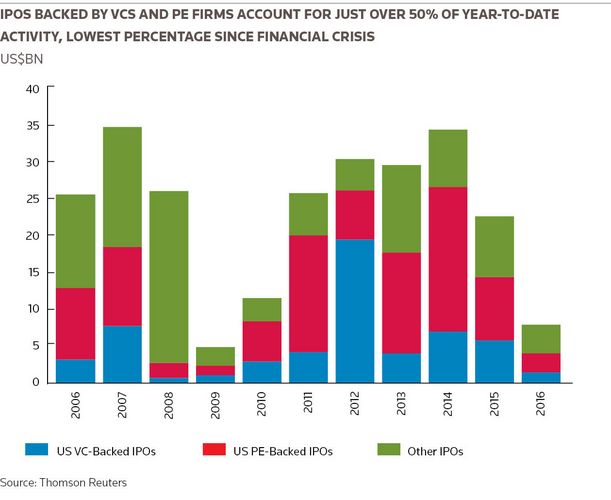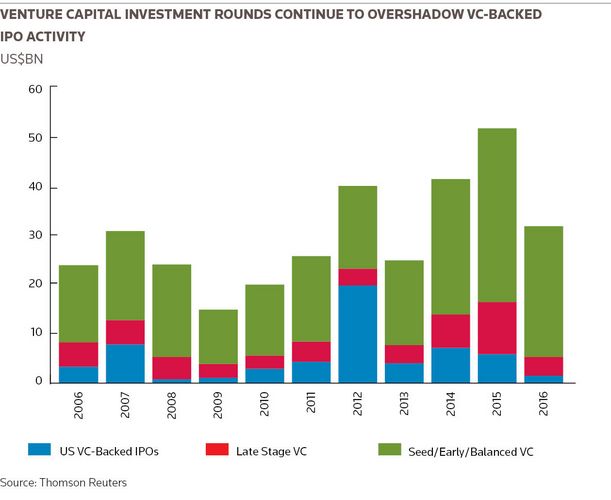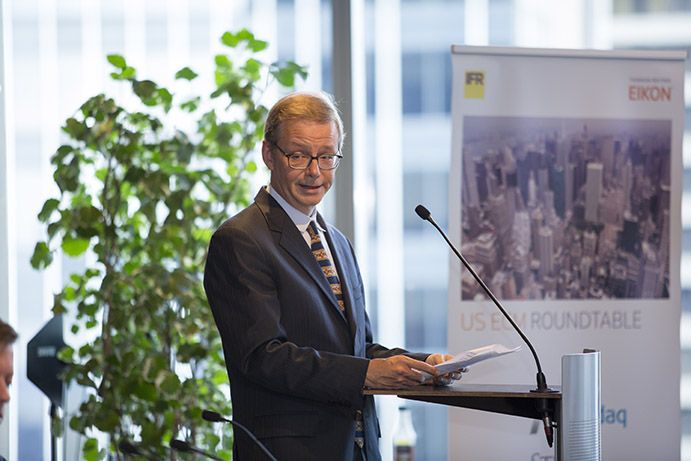IFR: Brett, on the one hand, we are saying the JOBS Act has been a success but on the other, there’s not been many IPOs this year. Is there much appetite for further IPO reform?
Paschke: It’s fun hearing it from a four or five-year perspective, because I was involved with the task force that helped make the recommendations that put the JOBS Act in place. The whole idea was about relieving pain points.
One of the pain points for sure from the management team’s perspective is that when we were sitting around drafting S-1s and and putting in competitive strengths and customer disclosure, management weren’t picturing Fidelity reading that, they were picturing their number one competitor reading it and their customers reading it and thinking about [profit] margins. They didn’t want that publicly known unless they knew for sure the IPO was going to happen.
That’s one of the reasons why you’ve seen confidential filings. Virtually every company that was eligible for it has done it and for multiple years. They may disclose that they’re on file, but you don’t have to disclose the filing itself.
What is happening now because of broad market acceptance is that confidential marketing is leaking into a lot of the other capital-raising processes it wasn’t originally intended for. You’re seeing truncated marketing periods. You’re seeing uniformity around release of research after deals, coming closer to transactions both on follow-ons and IPOs.
You’re seeing some of the provisions that were originally set up just for emerging growth companies, which have US$1bn or below of revenue, bleeding out into all companies. That’s one of the things going around Capitol Hill right now for JOBS Act 2.0 and 2.5 − to broaden out that impact.
IFR: But we really have not seen the market embrace provisions surrounding research coverage.
Paschke: Yes, one of the areas that the JOBS Act did try to change that it probably hasn’t had the intended impact was around earlier reporting of research. The way it’s worked in the market has been to release initiation research on an IPO on the 25th day [after the IPO]. There’s an agreement among underwriters on every deal to do that.
The original JOBS Act actually allowed people to release research pre-IPO, which is how it’s done in a lot of other markets outside the US.
The thought there was to get broader dissemination of information so that research wasn’t just going to underwriters’ favourite institutional clients, who in the end are the only people who get a lot of access to the information.
In some ways, the testing-the-waters meetings, the not releasing the research until 25th day, no public communication of forward estimates, all of these things that are still in place do make it pretty challenging for those [investors] that don’t have direct access to the underwriters to get information, and that was one of the original points.
[The JOBS Act] fixed the words but not the liability, because what that did was it transferred all of the liability to the investment banks. It made the research part of the prospectus and it made it impractical to actually do it, because then to underwrite the offering you had to be responsible for what every other investment bank’s research analyst said, as did the company. No one was willing to take that on. I would say that’s the one area where I think the intentions were good but market practice kind of outweighed it.
Griggs: There’s definitely a big appetite to continue working on the JOBS Act. We’ve spent a lot of time down at the SEC and Congress of late talking about some public company reforms we want to see, but certainly extending the JOBS Act to all companies is something that’s going to get some traction pretty soon. As Brett mentioned, 92% of companies qualify as emerging growth companies (EGCs) under the JOBS Act, so there’s really no reason why it couldn’t be expanded to all sorts of companies. You’ll see some more on the next round of JOBS Act in the next six months to a year.
IFR: Anna, maybe you could walk us through a little bit in terms of the testing the waters process, what that is, and pull the curtain from the process.
Pinedo: Sure, it’s very timely. Tomorrow there’s a mark-up of the CHOICE Act. Most of the provisions of the CHOICE Act are banking related. But there are important provisions of the securities laws covered by the CHOICE Act, including some of the things that we’ve just talked about, like extending the JOBS Act provisions to companies that aren’t just EGCs.
Likewise, the SEC has made great strides with some of the proposals to extend all the EGC privileges to companies that are smaller reporting companies. That affects almost all life science companies, so it’s a very important change that hopefully will get passed and will be supported.
In terms of testing the waters, certainly it was helpful for our biotech and life science companies, but we see now with pretty much every IPO there is some period of testing the waters. Obviously, those meetings with institutional-accredited investors and with qualified institutional investors are very useful. They result in important information on valuation, price range, how the business description is pitched, what expectations are in the biotech space regarding the next milestones for data and when the company should come to market. All of that is very significant.
A change that has been discussed in the United States which is available to transactions in Europe, relates to this notion of a cornerstone investor or an anchor investor. To Ashley’s point, it’s presumed that a lot of the investors that come in in crossover rounds are going to make important anchor orders and are going to indicate their interest in participating in the IPO and be important buyers in the IPO.
However, to date in the US you can’t get a firm commitment. You can only get an indication of interest. Or you could have those investors come in through a concurrent private placement, as opposed to in Europe, where you could get an actual commitment from those investors. For a lot of our biotech and smaller growth companies, having that actual commitment would be very, very meaningful.
IFR: Brian, do you ever extend testing the waters to marquee companies or some of the larger companies that may be well known to the market, perhaps because you want to begin the process with some momentum?
Reilly: That was sort of what I was referencing earlier. It depends on how you define marquee companies, because some of the companies are too big, so they’re not EGCs. So they don’t technically have access to the testing-the-waters provisions of the JOBS Act, but wherever we can do it we’re pretty much doing it these days.
What we’re also doing, and this is always subject to sign-off by counsel – is that even with companies that are not ECGs, we are taking these companies out after they file their prospectus. So long as they stick within the four corners of the document, they can do some pre-marketing. They don’t have necessarily the benefit of the safe harbour provision, but they can still do it.
That’s why I said earlier, “This has really turned into something.” The testing-the-waters provision has turned into something much bigger than I ever thought, because it’s not only benefiting the companies it was designed to benefit, but it’s actually benefiting other companies as well.
Scharfenberger: I only did this with Ollie’s, but I think it’s a great case study. Mark Butler, the CEO, he owns 25% of the company. He’s a great presenter. He loves talking to people about his business, but he definitely was intimidated a little bit about the IPO process.
The test-the-waters meeting allowed him to get out and talk to investors. He had a private equity board. But I think the notion of being public and kind of having everything about your company out in the public eye, ringing the bell – the whole nine yards of going public, the whole event – made him nervous.
The testing-the-water meetings really let the management team see what it’s like to have a bunch of different investors, to get the tough questions answered upfront. You start to build relationships with people that are likely to be your cornerstone investors. You can get a pretty good sense whether or not your roadshow and your bookbuilding process is going to go well.
Delp: Yes and it’s going to continue to lead to more accelerated actual IPO roadshows, or the time from when you kick off the deal until you price. We have a deal that’s launching this Wednesday that’s going to price next Thursday, which would be historically unheard of from an IPO marketing standpoint. We’ve done other deals that have marketed for five days.
It wouldn’t be that out of the ordinary (in the future) to launch an IPO on a Monday and price it on a Thursday. If you’ve done an extensive testing of the waters, investors are already familiar with the company. Because of confidential filing and a lack of visibility on the IPO backlog, testing the waters is of benefit when you come to the actual time of marketing the IPO.
Scharfenberger: Investors also like it. All buyside people, whether you’re in private equity or in the public markets, like to get a kiss before the actual process kicks off.
[In our case] the feedback we got from the investors was: “This is awesome. We get to learn a lot about the company and meet the management team before everybody else does”.
[As an investor] you can kind of start doing all your work and then come in with a strong indication, and hopefully develop a relationship with the management team whereby when they’re doing allocations, the CEO can say, “Yes, I want those guys. I’ve already met them. I like them”.
IFR: Can we move onto blocks? Joe, can talk about Ollie’s after the IPO. How does the block process work, and how have you utilised it to monetise your investment.
Scharfenberger: Yes. Ollie’s was a buyout we did in partnership with the founder of the company and CEO, Mark Butler. We did the deal almost four years ago to the day. It was in September of 2012.
We took it public in July of 2015. Jefferies was a bookrunner on that deal. Then we sold our last shares the Tuesday after Labor Day this year. So from the time we went public to the time we sold our last shares, we did either three or four [follow-on] deals; I can’t remember. I think it was just a little bit over a year, so that’s pretty quick.
We sold at escalating prices from the time we went public at US$16 a share. We sold our last shares to the Street at US$26.50 [in a block trade]. To us it was US$26.07. It was just a great deal for us.
Ollie’s is a high-growth retailer that has performed exceptionally well. They sell discount and branded merchandise at steep discounts, so anything you would buy in a Costco, a Wal-Mart, Bed Bath & Beyond, etcetera. They sell comparable product, comparable brands at much cheaper prices, so it is an incredible value proposition.
Mark Butler, like I said, was our partner in the buyout. He still runs the company. He didn’t sell in any of the follow-ons, except the first one. That really pissed him off because I think the net price was like US$17.50 or something like that, and now the stock is just around US$26.
The first couple of [follow-on] deals we did were traditional. There was a short roadshow, we paid a gross spread to the underwriting banks, and we priced the deals in the traditional fashion. [A year after the IPO] Ollie’s became a well-known seasoned issuer (WKSI), so that allowed us to do an overnight block sale.
The block we completed in September was a huge deal. It was close to 20-days’ average trading volume, close to 20% of the company and close to 40% of the free-float. It’s amazing: We transferred about US$350m of risk on a phone call in a 10-minute period from the time we solicited bids from the banks. We received their bids at 4:00pm, and the purchase was agreed by 4:10pm-4:15pm. No papers, no signatures, nothing.
Execution all comes after the fact. There is an agreed-upon price and then the banks start to syndicate out the shares shortly thereafter.
Block sales are an amazing tool and an increasingly larger part of the market. The net price to us was just a little bit over 3%. Compared that to a traditionally marketed deal where the stock trades down, you pay a gross spread of 475bp or something like that, and you price it at discount. All in, that’s usually 10% to 15%, where on this deal, we paid close to 3%. It was a very efficient tool for us.
IFR: Did you ask for a single bid from one bank or did you ask for multiple bids?
Scharfenberger: Some private equity firms use consultants. We don’t use consultants, but every private equity firm has their own process that they go through. We will go out to anywhere from two to four banks.
We have to get best execution. That’s a defined term in our limited partner agreement, so to do a negotiated deal with just one party is really tough for us. There has to be unique circumstances, but normally we’ll go out to two to four banks around noon. We have this all scheduled before we actually “launch”, but we’ll go out around noon and do diligence calls for the banks mid-afternoon.
You can talk to Brian and Ashley about what goes on behind the scenes. It’s amazing how close to each other they are in price when 4:01pm rolls round (Laughter).
IFR: So can we go behind the scenes, Brian?
Reilly: I’m not quite sure what Joe’s implying there (Laughter).
I never thought I’d see the day where we’d spend so much time talking about and executing blocks. Think back to 2011, and 2012, and 2013. Blocks were something like 15%–20% of follow-on volume. Last year they were 36%. This year block trades are 53% of all follow-on volumes.
What’s going on and can this continue? You go back to those days when not all of our competitors were really keen to do blocks. [IFR] gave us a little bit of a shout out and I appreciate it. This goes back to our days at Lehman Brothers. We were a little bit of a pioneer in terms of the processes we put in place.
We’d been doing it for a long time, but from 2011–13 there were still a lot of our competitors who looked at it as bad business that was cannibalising existing business, and they weren’t proactively looking to do blocks. They might well be right, but I will tell you without question every single one of them has thrown in the towel such that everybody is now in the block trade business. Particularly given that regular-way business has been down so much, we need to be doing it.
Joe and his [private equity] peers around the Street know that and they take full advantage of the competitive juices among the investment banks. It certainly helps that we have been in a low-volatility environment and in a bull market for a long time so that banks can take unnatural risks, which they have been doing, and get bailed out.
Personally, I don’t see anything that makes this dramatically change going forward. In many ways, the genie is out of the bottle. Everybody knows it’s a tool they can use. We’re starting to see it happen more and more in primary blocks.
I do believe though that one of two things inherently inconsistent with each other is going to happen. Either regular-way business is going to pick up, IPOs, converts, and follow-ons. Therefore, we and our competitors are not going to have to stumble all over ourselves to bid crazy-like for blocks. Either that’s going to happen or, on the other hand, volatility is going to come back and we’re going to enter a bad market.
That will inject a nice dose of reality back into the block trade market. So, I think the trend will slow one way or another, but I don’t think we’re going back to the days where blocks were only 15% to 20% of the market.
To see the digital version of this roundtable, please click here
To purchase printed copies or a PDF of this report, please email gloria.balbastro@tr.com



